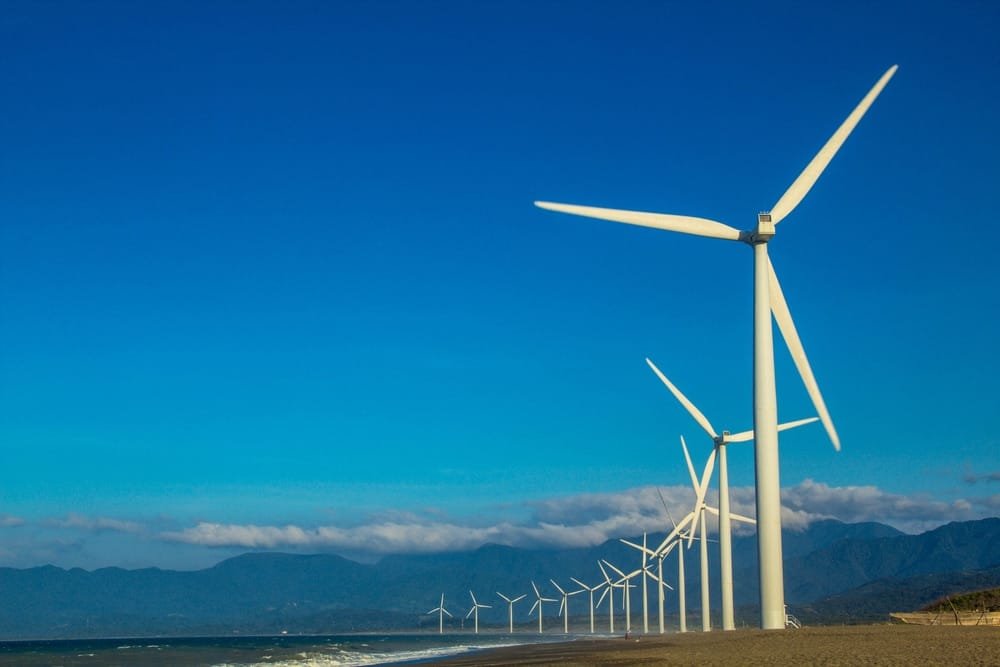Luzon’s northern regions are known to have scenic views and a rich culture. The wind farms of Ilocos Norte are a great example of their beautiful landscapes.
Beyond wind energy contributing to the Philippines’ energy portfolio, these facilities also appeal to tourists and residents as they show how different sources of energy, including renewables, are essential in supplementing our energy needs.
The Role of Wind Energy in the Philippine Energy Mix
In the Philippines’ diverse energy mix, wind energy serves as a complementary source of energy, along with solar energy. Though it cannot supply our increasing demand for energy on its own, it’s a great addition to improving our energy security along with sources such as coal, natural gas, and geothermal power.
Opportunities for Investment and Tourism
Policies such as the Renewable Energy Act of 2008 have encouraged investments in wind energy projects, creating opportunities to explore wind farms not just as power sources but also as destinations for energy tourism.
The Wind Farms of Ilocos Norte
Bangui Wind Farm
A prominent feature of Ilocos Norte, the Bangui Wind Farm’s line of wind turbines along Bangui Bay, has become an iconic image of tourism. This wind farm was established in 2005 and is now associated with the region, making it one of the famous tourist spots Filipinos might instantly remember when it comes to Ilocos.
Key Features:
- Capacity: 33 MW
- Tourism Appeal: Visitors enjoy the sight of windmills set against the scenic coastline, with 26 turbines lining the area.
Burgos Wind Farm
With the Burgos Wind Farm being the largest in the country, it cements the potential for renewables as essential to our energy portfolio. Even so, it only primarily supplements baseload power sources when demand is at its peak.
Key Features:
- Capacity: 150 MW
- Tourism Appeal: The rolling hills of Burgos offer a picturesque backdrop for wind turbines.
Caparispisan Wind Farm
Situated near Pagudpud, the Caparispisan Wind Farm highlights the beauty of Ilocos Norte while contributing to localized energy solutions.
Key Features:
- Capacity: 81 MW
- Tourism Appeal: Visitors often combine a trip to Caparispisan with other regional attractions, enjoying the balance of modern infrastructure and natural beauty.
Energy Tourism: A Growing Trend
Energy tourism, particularly in the context of wind farms, offers visitors a chance to explore how renewables fit within the broader energy mix.
Guided tours help travelers understand how having different sources of energy help meet the Philippines’ energy needs.
Additionally, the wind farms of Ilocos Norte have become tourism magnets, creating economic opportunities for local businesses and communities to benefit from visitor spending.
Exploring the Wind Farms
Travel Recommendations
The wind farms are most accessible during the dry season, from November to May. Visitors often combine their trips with nearby attractions like Pagudpud’s beaches, the Cape Bojeador Lighthouse, and the historic Paoay Church. Private vehicles, public buses (and tricycles around the area), and organized tours offer convenient access to these destinations, making them ideal for both solo travelers and family trips.
Wind Energy: Looking Ahead
While wind farms symbolize progress in exploring renewable energy sources, it’s important to recognize their limitations.
Renewables like wind and solar power are intermittent by nature, requiring integration with more reliable baseload energy sources. Moving forward, the Philippines must continue to prioritize a balanced and sustainable energy mix that supports long-term energy security.
The wind farms of the north serve as a reminder of the innovative approaches available to meet energy needs while contributing to economic growth through tourism. These wind farms serve as more than just supplementary energy sources; they raise awareness about meeting the country’s growing energy needs while also creating economic opportunities.
References:
https://doe.gov.ph/announcements/renewable-energy-champions-ilocos-wind-farm
https://doe.gov.ph/sites/default/files/pdf/issuances/20081216-ra-09513-gma.pdf

